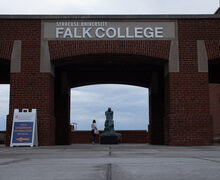Clint Smith discusses book ‘How the Word is Passed’, transition into journalism
Screengrab
Smith said he decided to write the book because his 15-year-old self was desperate to know why his environment looked the way it did, whether those perceptions were explicit or subtle.
Get the latest Syracuse news delivered right to your inbox.
Subscribe to our newsletter here.
Poet and journalist Clint Smith spoke to Syracuse University community members about his latest book, “How the Word is Passed,” via Zoom on Wednesday night. The talk was part of the Newhouse School of Public Communications’ Leaders in Communications speaker series. Melissa Chessher, a professor of magazine, news and digital journalism, hosted the Q&A with Smith.
Smith, who is a staff writer at The Atlantic, spoke about how he sought to create a narrative nonfiction work that chronicled the pervasive nature of slavery on contemporary American society. He noted that some of the most visible examples of this are through the glorification of prominent Confederate figures through monuments, street names and the names of schools.
“The thing is, we know that symbols and names and iconography aren’t just symbols. They’re reflective of the stories that people tell. And those stories shape the narratives that communities carry. And those narratives shape public policy and public policy shapes the material conditions of people’s lives,” Smith said.
Taking down these statues would help people recognize what has shaped how American history is understood, with emphasis on the way that certain communities have been disproportionately and intentionally harmed, he said.
Although Smith recently became a journalist by trade through his work at The Atlantic, he said that he still struggles with the label because of the intersectional nature of his work.
“I didn’t go to journalism school or communication school, and I don’t even come from a media background,” he said. “I’m kind of an untraditional journalist. It’s a weird experience and even when the reviews of this book started coming out, because almost every reviewer was like, ‘poet and journalist.’ And I was like, who’s the journalist? Who are they talking about? That’s not something that was a part of my identity, like my personal or professional identity, until recently.”
Smith’s first experience with person-on-the-street interviews was on a tour of Thomas Jefferson’s home, Monticello. The guide discussed the fact that Jefferson knew slavery was wrong yet continued to enslave people, which made several members of the tour visually uncomfortable.
“They were clearly unsettled by what they were hearing, and I had a moment where I was like, ‘I should go talk to them,’” Smith said. “Going up and walking to a group of white people on a plantation and asking them how I feel about slavery is not part of my natural ethos. But I did it. And it was so important that I did it.”
Smith said he decided to write the book because his 15-year-old self was desperate to know why his environment looked the way it did, whether those perceptions were explicit or subtle.
“If the reader leaves the book with one thing, my hope is that it’s a clear sense of how recent this was and that it really was not that long ago,” he said.
Published on April 7, 2022 at 12:15 am
Contact Danny: [email protected] | @dannyamron_





